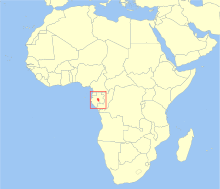Suntail monkey
| Suntail monkey | ||||||||||||
|---|---|---|---|---|---|---|---|---|---|---|---|---|

Suntail monkey ( Allochrocebus solatus ) |
||||||||||||
| Systematics | ||||||||||||
|
||||||||||||
| Scientific name | ||||||||||||
| Allochrocebus solatus | ||||||||||||
| ( MJS Harrison , 1984) |
The Sonnenschwanz- or Gabon monkey ( allochrocebus solatus , Syn. : Cercopithecus solatus ) is a primate of the tribe the sea felids (Cercopithecini) within the family of Cercopithecidae (Cercopithecidae). The species was first described in 1984 .
features
Suntail monkeys reach a head body length of 50 to 70 centimeters and a tail length of 60 to 76 centimeters. The weight is 4 to 9 kilograms, with the males becoming larger and heavier than the females. The fur of these animals is predominantly gray-blue in color, they have a white frill on their necks, and their backs are partly orange-brown. The name-giving feature is the orange-colored tip of the tail, the rest of the tail is white on the underside and gray on the top.
distribution and habitat
Suntail monkeys only inhabit a small area of around 10,000 km 2 in the central part of Gabon . Their habitat are areas with dense vegetation, mainly forests.
Way of life
These animals are diurnal and mainly stay on the ground. To sleep, however, they retreat to the higher areas of the trees. They live in harem groups of an average of 17 animals, which means that they are made up of a male, several females and their young animals.
The diet of these monkeys consists of fruits, seeds, leaves, insects and small vertebrates.
On average every one and a half years, the female usually gives birth to a single young after a gestation period of around five to six months. This becomes sexually mature at around four years of age.
threat
Due to its limited range, the species is listed as endangered ( vulnerable ) by the IUCN . However, parts of its distribution area are in the Lopé National Park.
Systematics
The closest relatives of the suntail monkey are the western full-bearded monkey and the eastern full-bearded monkey . Together they form the genus Allochrocebus within the tribe of the vervet monkeys (Cercopithecini).
literature
- Thomas Geissmann : Comparative Primatology. Springer-Verlag, Berlin et al. 2003, ISBN 3-540-43645-6 .
- Don E. Wilson, DeeAnn M. Reeder (Eds.): Mammal Species of the World. A taxonomic and geographic Reference. Johns Hopkins University Press, Baltimore MD 2005, ISBN 0-8018-8221-4 .
Web links
- Information and photos at arkive.org
- Information at theprimata.com
- Allochrocebus solatus in the endangered Red List species the IUCN 2006. Posted by: Butynski et al, 2000. Retrieved on 11 May, 2006.
